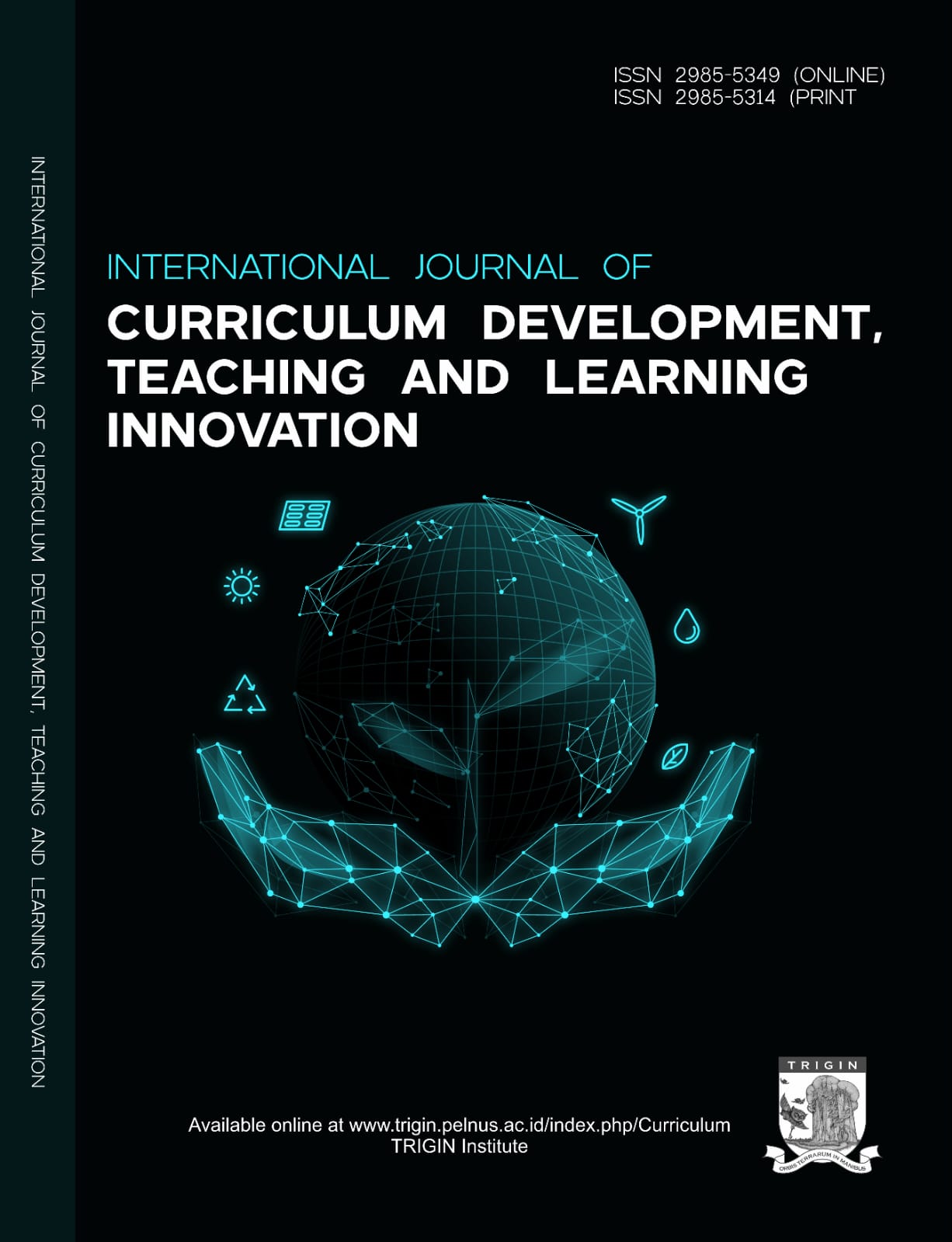The Effectiveness of Online Collaborative Learning through Digital Platforms in Enhancing Students’ Communication Skills
##plugins.themes.bootstrap3.article.main##
Abstract
This research investigates the effectiveness of online collaborative learning using digital platforms in enhancing students’ communication skills, a core competency in 21st-century education. Communication skills are increasingly vital for academic success and professional readiness, making it essential to explore innovative pedagogical strategies that foster interaction in digital learning environments. Drawing on theories such as Vygotsky’s social constructivism and collaborative learning theory, this study examines how structured online collaboration contributes to the development of students’ ability to express ideas, negotiate meaning, and engage in constructive dialogue. The methodology employed a mixed-method approach, combining surveys, classroom observations, and interviews with students engaged in collaborative tasks via digital platforms. The results indicate that online collaborative learning significantly improves communication skills by promoting active participation, reflective practices, and peer-to-peer interaction. Furthermore, challenges such as unequal participation and technological barriers can be mitigated through scaffolding, role assignments, and clear communication guidelines. These findings align with previous studies while offering new insights into the role of reflective learning and instructional design in digital collaboration. The study contributes to both digital pedagogy and educational policy by highlighting the need for professional development programs for teachers, the integration of collaborative learning into curricula, and equitable access to digital resources. Ultimately, the research affirms that online collaborative learning is an effective pedagogical strategy not only for improving academic outcomes but also for equipping students with essential communication skills required in modern education and the global workforce.
##plugins.themes.bootstrap3.article.details##
Ainscow, M. (2020). Promoting inclusion and equity in education: lessons from international experiences. Nordic Journal of Studies in Educational Policy, 6(1), 7–16.
Bakar, S. (2021). Investigating the dynamics of contemporary pedagogical approaches in higher education through innovations, challenges, and paradigm shifts. Social Science Chronicle, 1(1), 1–19.
Blau, I., Shamir-Inbal, T., & Avdiel, O. (2020). How does the pedagogical design of a technology-enhanced collaborative academic course promote digital literacies, self-regulation, and perceived learning of students? The Internet and Higher Education, 45, 100722.
Carter, D. F., Ro, H. K., Alcott, B., & Lattuca, L. R. (2016). Co-curricular connections: The role of undergraduate research experiences in promoting engineering students’ communication, teamwork, and leadership skills. Research in Higher Education, 57(3), 363–393.
Eraković, B. R., & Topalov, J. P. (2021). Teaching and learning through Moodle, Google Doc and Zoom: Fostering student engagement in (a) synchronous learning environments. Inovacije u Nastavi-Časopis Za Savremenu Nastavu, 34(4), 122–136.
Hakkarainen, K., Paavola, S., Kangas, K., & Seitamaa-Hakkarainen, P. (2013). Sociocultural perspectives on collaborative learning: Toward collaborative knowledge creation. In The international handbook of collaborative learning (pp. 57–73). Routledge.
Hsieh, Y. C. (2017). A case study of the dynamics of scaffolding among ESL learners and online resources in collaborative learning. Computer Assisted Language Learning, 30(1–2), 115–132.
Huang, X. (2018). Improving communicative competence through synchronous communication in computer-supported collaborative learning environments: A systematic review. Education Sciences, 8(1), 15.
Johnson, D. W., & Johnson, R. T. (2008). Social interdependence theory and cooperative learning: The teacher’s role. In The teacher’s role in implementing cooperative learning in the classroom (pp. 9–37). Springer.
Li, Q., Lau, R. W. H., Shih, T. K., & Li, F. W. B. (2008). Technology supports for distributed and collaborative learning over the internet. ACM Transactions on Internet Technology (TOIT), 8(2), 1–24.
Männistö, M., Mikkonen, K., Vuopala, E., Kuivila, H.-M., Virtanen, M., Kyngäs, H., & Kääriäinen, M. (2019). Effects of a digital educational intervention on collaborative learning in nursing education: A quasi-experimental study. Nordic Journal of Nursing Research, 39(4), 191–200.
McLeod, S. A. (2012). Zone of proximal development.
Moallem, M. (2015). The impact of synchronous and asynchronous communication tools on learner self-regulation, social presence, immediacy, intimacy and satisfaction in collaborative online learning. The Online Journal of Distance Education and E-Learning, 3(3), 55–77.
Müller-Bloch, C., & Kranz, J. (2015). A framework for rigorously identifying research gaps in qualitative literature reviews.
Novıana, A., Abdurrahman, A., Rosıdın, U., & Herlına, K. (2019). Development and validation of collaboration and communication skills assessment instruments based on project-based learning. Journal of Gifted Education and Creativity, 6(2), 133–146.
Onyema, E. M., Deborah, E. C., Alsayed, A. O., Noorulhasan, Q., & Sanober, S. (2019). Online discussion forum as a tool for interactive learning and communication. International Journal of Recent Technology and Engineering, 8(4), 4852–4859.
Parchoma, G. (2014). The contested ontology of affordances: Implications for researching technological affordances for collaborative knowledge production. Computers in Human Behavior, 37, 360–368.
Roberts, S. M., & Pruitt, E. Z. (2008). Schools as professional learning communities: Collaborative activities and strategies for professional development. Corwin Press.
Saini, C., & Abraham, J. (2019). Implementing Facebook-based instructional approach in pre-service teacher education: An empirical investigation. Computers & Education, 128, 243–255.
Shekhar, P., Prince, M., Finelli, C., Demonbrun, M., & Waters, C. (2019). Integrating quantitative and qualitative research methods to examine student resistance to active learning. European Journal of Engineering Education, 44(1–2), 6–18.
Singh, A., Sharma, S., & Paliwal, M. (2021). Adoption intention and effectiveness of digital collaboration platforms for online learning: the Indian students’ perspective. Interactive Technology and Smart Education, 18(4), 493–514.
Sobko, S., Unadkat, D., Adams, J., & Hull, G. (2020). Learning through collaboration: A networked approach to online pedagogy. E-Learning and Digital Media, 17(1), 36–55.
Sun, Z., Lin, C., Wu, M., Zhou, J., & Luo, L. (2018). A tale of two communication tools: Discussion‐forum and mobile instant‐messaging apps in collaborative learning. British Journal of Educational Technology, 49(2), 248–261.
Ware, P. D. (2004). Confidence and competition online: ESL student perspectives on web-based discussions in the classroom. Computers and Composition, 21(4), 451–468.
Wiecha, J., & Barrie, N. (2002). Collaborative online learning: a new approach to distance CME. Academic Medicine, 77(9), 928–929.
Wrahatnolo, T. (2018). 21st centuries skill implication on educational system. IOP Conference Series: Materials Science and Engineering, 296(1), 12036.

This work is licensed under a Creative Commons Attribution-NonCommercial 4.0 International License.
